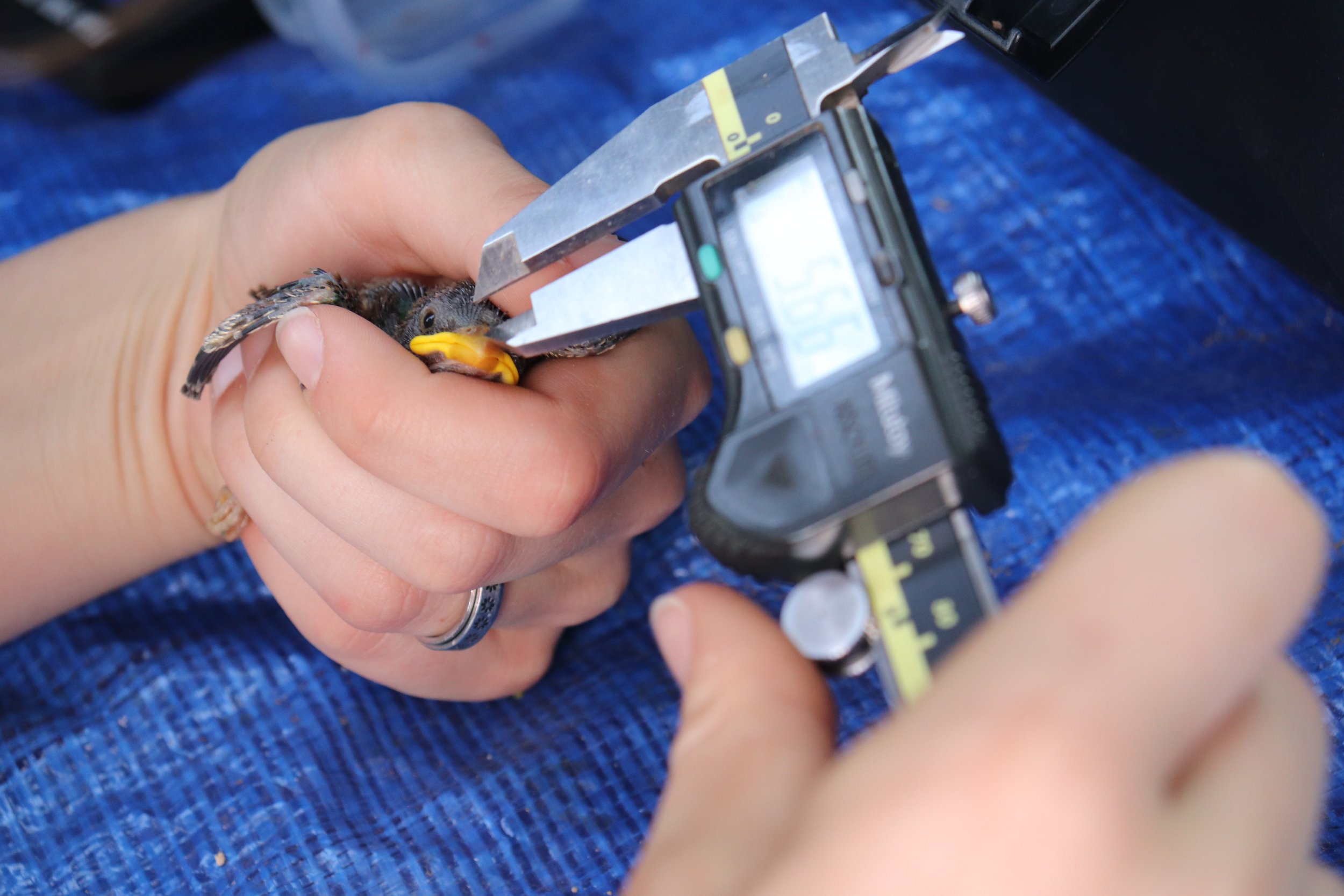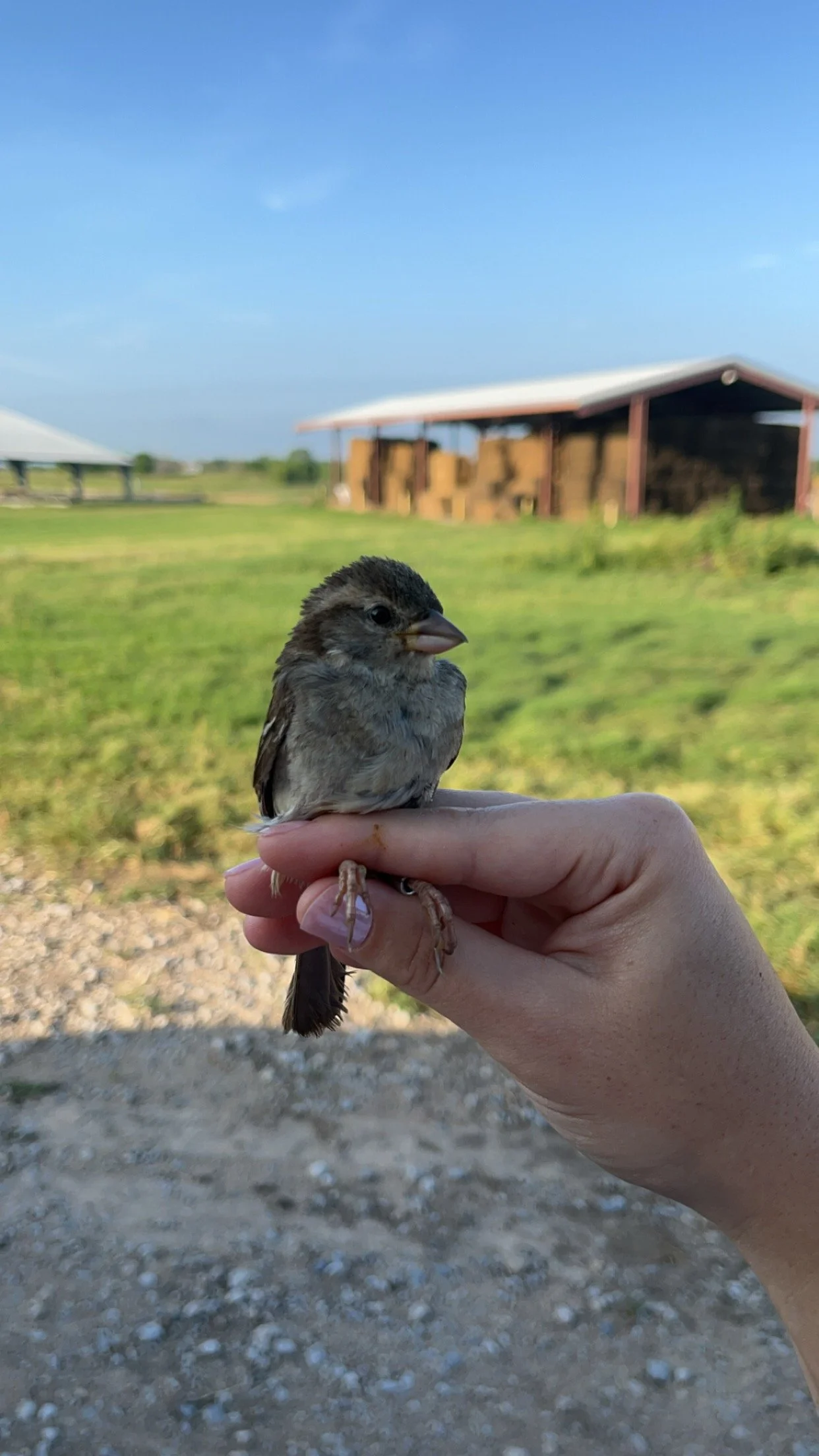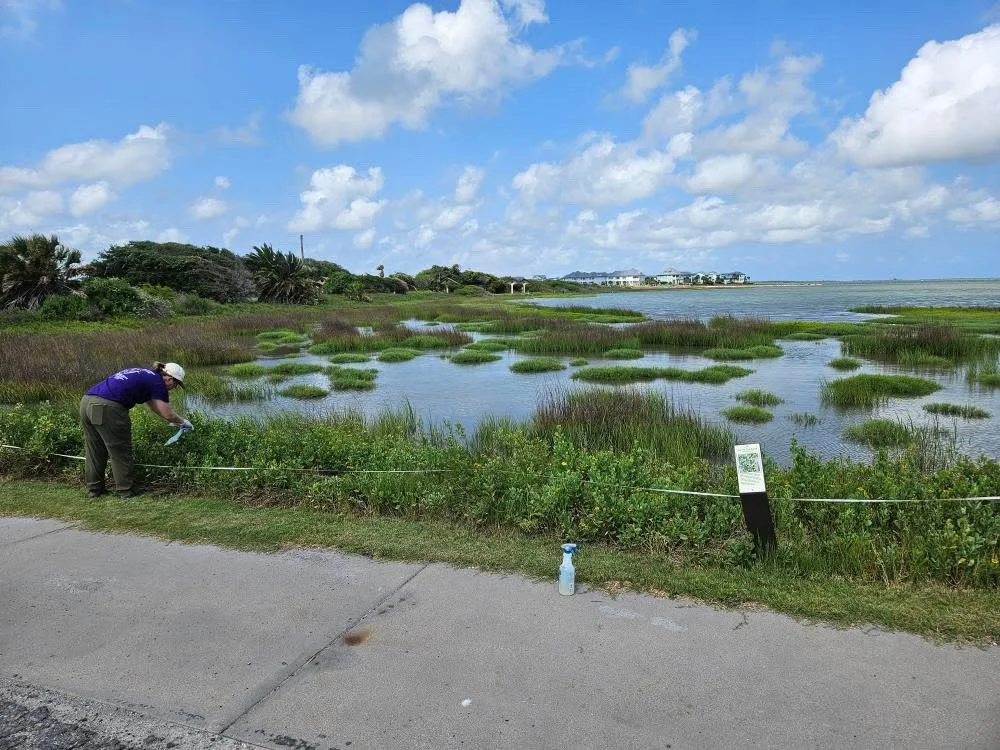House Sparrow Projects
This project is a large collaborative research program funded by the National Science Foundation and was started out of North Dakota State University with Dr. Britt Heidinger research on “Rapid phenotypic divergence and insulin-like growth factor 1 (IGF-1) signaling in a widespread songbird”. This program is investigating the underlying mechanisms of Bergmann's rule, which states that populations of organisms should have larger body sizes in higher latitudes due to a better ability to retain heat in those colder climates. We have study sites in Fargo, ND, Easton, PA, Lexington, KY, Stillwater, OK, and Stephenville, TX to create a latitudinal temperature gradient. House sparrows have been selected as our study species because they are a widespread species that readily uses nest boxes and have exhibited body size differences according to Bergmann's rule. Here in Texas, Lindsey Willingham, PhD student, is leading investigations on differences in parental behavior during both the incubation and nestling period relative to extreme temperatures. She also is investigating associations between weather and embryo mortality. Many other students have been involved in this research including many at NDSU and OK State, and in our lab this includes Alex Hoxie, Samantha Aguilar, Gracie Gold, Catalina Berry, and Jordan Morgan.
PIs include: Drs. Britt Heidinger (NDSU), Jenn Grindstaff (Oklahoma State Univ.), David Westneat (University of Kentucky), and former post-doctoral assistants at NDSU, Samuel Lane, Gabby Names
Microplastic Studies
MS student Alex Hoxie and PhD student Lindsey Willingham assisted with the planning and implementation of this research in 2023. In collaboration with Dr. Adam Mitchell and Dr. Rajani Srinivasan (Chemistry, Tarleton State Univ.), we are investigating the ingestion of microplastics in house sparrow nestlings. Microplastics are a form of plastic pollution that is commonly ingested by both humans and wildlife, however, songbirds remain understudied compared to other groups of birds, such as seabirds.
We are evaluating the use of fecal samples as a nonlethal alternative to examining full gastrointenstinal tracts. Since fecal samples are an emerging method in this field, we are also interested in refining these methods by determining when and how to sample nestlings in order to accurately evaluate microplastic ingestion in songbirds. In 2024, we began collecting arthropods that serve as a food source for nestlings, with Ph.D. student Addison Singleton, to evaluate potential sources of microplastics. Several undergraduate researches have participated in this research, Jordan Morgan, Grace Hurta, Gracie Triplett, Maeson Leonard.
Hatching Failure Study
PhD student Lindsey Willingham is using house sparrows to investigate the influence of environmental factors on hatching failure and how embryo survivability varies with changes in environmental conditions.
Hatching failure is defined as an egg that remains in the nest the duration of the incubation period but fails to hatch. This is a common phenomenon in wild birds, with an average 10% of produced eggs failing to hatch. Eggs fail to hatch for one of two reasons, either fertilization failure or embryo mortality. If the egg was fertilized and embryo mortality occurred then the cause is often uncertain and complex, and most hatching failure studies focusing on poultry or threatened and endangered species with above average hatching failure rates and likely reproductive complications. By using an abundant species, we can avoid those random demographic and genetic issues.
We collect all unhatched eggs from nests to examine in the lab. We distinguish between fertilization failure and early embryo mortality when possible and stage the embryos to determine their exact death date. We can then examine what environmental factors like temperature, precipitation, and humidity were doing on the days leading up to the mortality event.
Other associated research:
Using stable isotopes to identify food sources for nestling songbirds and to determine invertebrate food web. L. Willingham, A. Hoxie, A. Singleton,
Presence of Microplastics in Arthropods Ingested by House Sparrows. Ashley Bratten, undergraduate researcher
How does temperature across a latitudinal gradient affect house sparrow egg mass? Grace Hurta, undergraduate researcher
Parental attentive ness in house sparrows across a latitudinal temperature gradient. Samantha Aguilar, Gracie Gold, undergraduate researchers
Turkey Peak Mitigation Project
The Turkey Peak Mitigation Project is an ongoing restoration project involving the removal of Ashe Juniper and re-seeding efforts of native grasses to restore the riparian areas of the study site, Palo Pinto Mountains State Park, to its historical vegetation structure to increase groundwater infiltration and water flow through Palo Pinto Creek. We conduct vegetation surveys, songbird surveys, waterfowl surveys, and year-round camera trapping to assess the ecological impacts of riparian Ashe juniper mitigation. Dr. Darrel Murray, Tarleton State University, is a Co-PI.
Projects associated with this research:
Vegetation Responses After Disturbance from Ashe Juniper Removal
Another focus of the Turkey Peak Mitigation Project and Zach Bellows’s thesis work is investigating the responses to riparian herbaceous and woody vegetation after the removal of heavily encroached Ashe juniper. With the removal phases, we have conducted native re-seeding along riparian buffers along both intermittent and ephemeral streams along the site. Removal of woody encroachment began in 2020, and preliminary data has been collected before removal on all riparian buffers. Vegetation surveying occurs every year from June-July and analysis of the vegetation data aids to our understanding of how the landscape is responding and allows for us to adapt our management strategies for restoring these riparian ecosystems. Restoration of this study site in ongoing.
Temporal Activity and Overlap in Ephemeral and Intermittent Stream Ecosystems by Camera Traps in North-Central Texas
Included under the Turkey Peak Project and Ricky Garibay's thesis, this study investigates the spatial and temporal interactions among feral pigs (Sus scrofa), white-tailed deer (Odocoileus virginianus), and coyotes (Canis latrans) within the riparian ecosystems of Palo Pinto Mountains State Park, Texas. Utilizing camera trap data from ephemeral and intermittent stream habitats, the research aims to understand how these species interact seasonally, utilize resources, and partition space and time, particularly in the context of invasive feral pigs altering habitat structure and potentially impacting the behavior of native species.
By examining species' activity patterns and site detection densities, this research seeks to inform conservation efforts and wildlife management strategies in these vital ecosystems. The central hypothesis suggests that observation events and densities will vary significantly among species and tracts due to habitat characteristics, with each species exhibiting distinct site usage patterns, and feral pigs demonstrating the most generalist behavior.
Seasonal Abundance and Site Use of Three Waterfowl Species in North-Central Texas
Included under the Turkey Peak Mitigation Project and Chloe Delahoussaye’s undergraduate research, this study aims to investigate how waterfowl species overlap in water resource use through site presence on stock tanks within Palo Pinto Mountains State Park, Texas. For this project, surveys are conducted on two ponds twice a month from October to March. 19 trail cameras are located on two ponds and Palo Pinto Creek to collect year-round data on waterfowl abundance and species composition. With this data, we can make management decisions on whether to keep the ponds for waterfowl use or to remove the ponds to increase streamflow into Palo Pinto Creek, which is the overall goal of the Turkey Peak Mitigation Project.
Does Restoration of a Riparian Area Affect Songbird Populations and Communities
Included under the Turkey Peak Mitigation Project and Cameron Starnes’s thesis, this study evaluates how the mechanical removal of Ashe juniper and the re-seeding of native grasses affects songbird population trends along ephemeral and intermittent streams in Palo Pinto Mountains State Park, Texas. Point count surveys have been conducted since 2021 at 20 points along narrow riparian corridors within vegetation removal areas. Surveys are conducted 7 months of the year to provide a better understanding of how songbirds utilize the study area throughout the year. With this data, we can make informed management decisions that benefit both the vegetation structure and avian communities of north-central Texas.
Photo: Hannah Pepper Atkinson
Anthropogenic Risks to Wildlife
This project is contracted with the Texas Department of Transportation (TxDOT), studying risks that erosion control products (ECPs) may pose to wildlife in Texas.
TxDOT currently has an approved products list for ECPs that can be used for road construction projects. This list currently categorizes some products as “wildlife friendly” based on manufacturers’ classifications, but this is not standardized between companies, and is often based on the lifespan of the product after deployment.
Construction contractors are required to install ECPs upon completion of projects to reduce soil erosion and promote regrowth of vegetation; however, there have been anecdotal reports of wildlife experiencing entanglement and mortality in ECPs, specifically erosion control blankets, and there is a particular concern for risks posed to threatened and endangered species in Texas.
Erosion control blankets are composed of one or two mesh or woven blankets with an inner matrix made of synthetic or natural materials, bound together by synthetic or natural stitching. We are testing several erosion control blankets with varying types of blankets and matrices with the goal of determining which product characteristics contribute to higher entanglement and impediment risks for animals that interact with these products.
The focal species of this study include invertebrates, amphibians, and reptiles, with plans to include small mammals in the future. Several of these species are representative of at-risk species in Texas.
Ultimately, we will provide TxDOT with rankings of different ECPs based on their “wildlife-friendliness,” or the risk of impediment and entanglement they pose to wildlife. These rankings will be included on TxDOT’s approved products list, which can be accessed by road construction contractors when deciding on the type of ECP to deploy after completion of their projects.
We hope that this will allow contractors to make informed decisions when choosing materials, and find products that will satisfy requirements for preventing erosion while also reducing risk to wildlife that may encounter these products in their habitat.
Environmental DNA Monitoring Project
In collaboration with Dr. Adam Mitchell’s lab, this project’s goal is to assess the distribution and status of the rare Variable cuckoo bumble bee (Bombus variabilis) and its host, the American bumble bee (Bombus pensylvanicus), using novel environmental DNA (eDNA) techniques. This is a statewide project with 14 study clusters across the state of Texas, where we are sampling for flowering vegetation for eDNA analysis along with traditional methods of monitoring as a point of comparison.
Due to the elusive nature and critically endangered state of B. variabilis, the use of floral eDNA will allow us to detect its presence over large spacial areas. It will also give insight to the benefits and limitations of eDNA monitoring methods as an indirect, non-lethal surveying technique.
This project works alongside Texas Comptroller of Public Accounts, Texas Parks & Wildlife and Texas A&M AgriLife.
Photo: Hannah Pepper Atkinson
Nonbreeding Grassland Bird Habitat Restoration Project
The overarching goal of the Nonbreeding Grassland Bird Habitat Restoration Project is to monitor the understudied wintering grassland birds in the Cross Timbers ecoregion, understand their habitat associations, and restore historic grasslands. This project will include removing woody encroachment and reseeding with native grasses to improve grassland bird habitat at Palo Pinto Mountains State Park, along with additional sites in the future. This project is made possible by the Tarleton Department of Wildlife and Natural Resources, Texas Parks & Wildlife, and the Native Plant Society of Texas.
Creating Distribution Models of Nonbreeding Grassland Birds in the Western Cross Timbers Ecoregion using eBird Data
Included under the Nonbreeding Grassland Bird Habitat Restoration Project and the thesis of Catalina Berry, the goal of this project is to use eBird data to model the distribution and encounter rate of nonbreeding grassland birds in the Western Cross Timbers ecoregion of Texas, assess the relationship between the top environmental associations and encounter rate of the target species, and evaluate the performance of current best modeling practices with eBird data when applied to a rural area with few observations and a group of underrepresented species. The Cornell Lab of Ornithology provided consultation for this project, and it will continue to be improved and expanded in the future.
SNAPSHOT USA: A Nationwide Mammal Monitoring Effort
The Snapshot USA is a large-scale national wildlife monitoring initiative led by the Smithsonian Institution in partnership with the North Carolina Museum of Natural Sciences. It involves camera trap surveys to monitor mammals across the United States. Established in 2019, this ongoing project was created through collaboration among researchers from more than 150 institutions, including universities, government agencies, nonprofit organizations, tribal groups, and high schools. Its goal is to develop a long-term, standardized database documenting the distribution, relative abundance, and behavior of mammal species nationwide (Snapshot USA 2022).
Doctoral student Ricky Garibay has been leading local participation in Snapshot USA for three consecutive years, supported by dedicated volunteers and technicians. Their efforts started at the original field site in Strawn, Texas, which continues to provide valuable long-term ecological data for the national dataset. Building on this success, Ricky will expand the project in fall 2025 with four new research sites. These new locations will enhance regional contributions to the Snapshot USA project and improve our understanding of mammal communities in diverse Texas landscapes. Student involvement is a key part of our work.
As part of his doctoral research, Ricky Garibay is utilizing Snapshot USA data to investigate broad ecological questions about mammal communities across both local and national scales. His research encompasses three interconnected themes:
· Community-level shifts in mammalian diversity across environmental gradients: Ricky examines how the composition, diversity, and abundance of mammal communities change along rural/urban transitions, elevation gradients, and climate zones.
· Temporal trends in mammal activity and distribution in response to climate anomalies: His analyses will focus on how extreme events, such as droughts, heatwaves, and late frosts, affect mammal presence, daily activity patterns, and species interactions.
· Invasion ecology at a continental scale: Expanding beyond single-region studies, Ricky investigates which environmental, land-use, or biogeographic factors predict the presence and spread of invasive mammals like feral pigs across the United States. By linking Snapshot USA data with land cover and development information, he aims to identify developing hotspots and evaluate whether established ecological theories hold true at the national scale.
By leveraging the standardized spatial coverage and robust datasets of Snapshot USA, Ricky’s work enables the detection of large-scale ecological patterns and rare transitions that cannot be captured via traditional field methods.
Since the start of their collaboration in 2022, Dr. Heather Mathewson and Ricky Garibay have been credited as co-authors on one published paper. They are listed as co-authors on another upcoming manuscript as well.
Rooney, B., Kays, R., Cove, M. V., Jensen, A., Goldstein, B. R., Pate, C., Garibay, R., & Mathewson, H. A. 2023. SNAPSHOT USA 2019–2023: The first five years of data from a coordinated camera trap survey of the United States. Dryad. https://doi.org/10.5061/dryad.k0p2ngfhn.
Plant DRIPS
The Plant DRIPS (Plant Drought Response and Insect Pollinator Studies) research project, lead by Principal Investigator Dr. Adam Mitchell, Tarleton State University, is a collaborative effort between Tarleton State University and East Texas A&M University that seeks to mitigate negative effects of drought and urbanization to flower visitor habitat by identifying drought-tolerant landscape perennials that provide quality resources to insect flower visitors in north central Texas.
The Plant DRIPS project has provided various research opportunities to graduate and undergraduate students such as understanding pollinator foraging preferences and how these change during drought, caterpillar use of drought-tolerant landscape perennials and how use changes during drought, exploring pollinator community networks under drought, and examining floral rewards under drought and how this affects pollinator behavior.
Photo: Addison Singleton
















